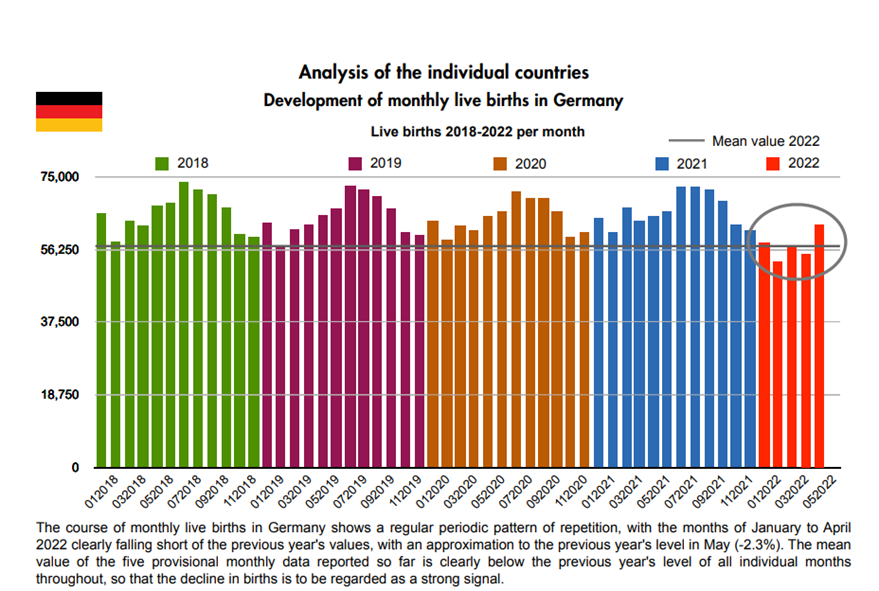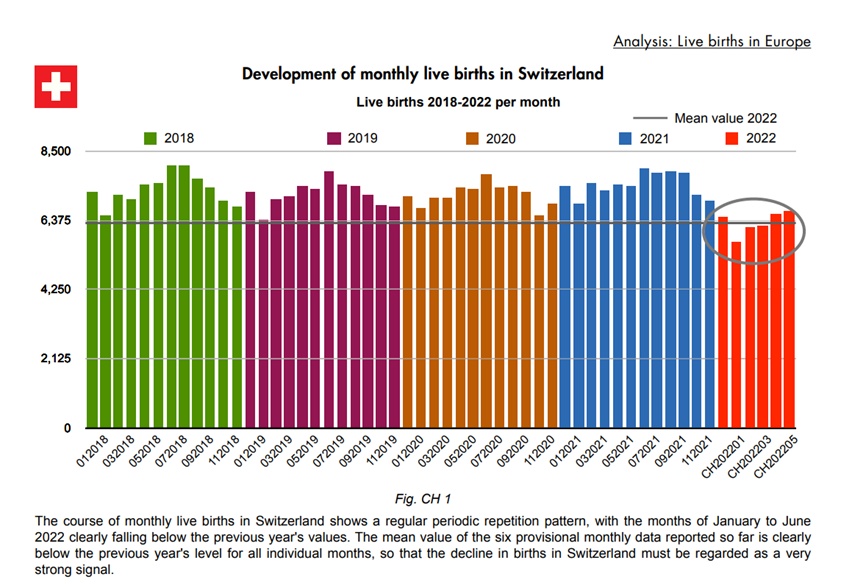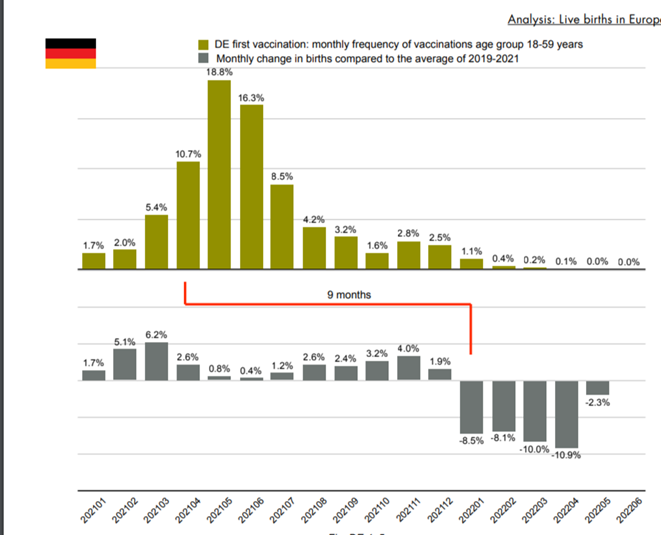
Examining all possible causes
HART recently published concerns about the wisdom of Covid-19 vaccination in pregnancy and we now look further into recent reports from many countries about falling birth rates. The big question, to which we have no clear answer, is whether these two issues are linked. Birth rates have been declining in recent years but there does appear to have been a sharper decline in 2022.
Hagemann et al in August 2022 published an analysis of birth rates in Europe. The paper includes a detailed methods section, outlining how they calculated the proportion of young adults being vaccinated in each month from January 2021 and then correlated vaccine uptake with birth rates 9 months later.
The birth rate from Germany shown in Figure 1 strongly resembles the pattern seen repeatedly across the countries of Europe.

Figure 1: Monthly live births in Germany January 2018 to May 2022
An almost identical pattern is seen in Switzerland.

Figure 2: Monthly live births in Switzerland January 2018 to May 2022
Reduced birth rates in 2022 spread right across Europe to a lesser or greater degree, as shown below.

Table 1: Change in birth rate in 2022 in 19 European countries
So what could be causing the decline in live births?
The explanations fall into 2 basic categories: either fewer women are becoming pregnant and/or there are more pregnancy losses.
1. Fewer pregnancies:
a. Choice – are people less confident about the future, whether economic or climatic or other societal pressures, and has this affected the choice of pregnancy? Or, did they choose not to get pregnant around the time of vaccination?
b. Lack of opportunity – did lockdowns prevent people meeting and making relationships?
c. Are there more problems with fertility/conception (both male and female causes)?
2. More pregnancy losses:
a. Spontaneous miscarriages
b. Terminations
c. Stillbirths
The first group of ‘societal’ reasons (1a) are beyond the scope of this article but should not be disregarded. Lockdown effects (1b) seem unlikely to be a major factor, in that the birth rates in 2021 continued to follow the pattern of previous years. However, there remains a question of the time lag between a relationship starting and the arrival of the first baby.
This leaves ‘medical’ causes of infertility (1c) and pregnancy losses (2) from miscarriages (2a) and/or terminations (2b) and/or stillbirths (2c).
Returning to Hagemann’s European data, the authors illustrated a 9 month time lag between vaccine rollout to young adults and the point at which birth rates drop below the 2019-2021 monthly average. The chart below shows monthly percentage vaccine uptake in younger adults in the top half of the graph and change in birth rates in the lower half (Figure 3). This is likely too simplistic for what is almost certainly multifactorial, but nevertheless when replicated in many countries, raises some uncomfortable questions.

Figure 3: Percentage vaccine uptake and change in birth rates – Germany January 2021 to June 2022
Fertility/conception:
Fertility rates (pregnancies per 100,000 women) fluctuate in time and place for many reasons but there has been concern at a general downward trend. Whilst for those concerned at the ability of the earth to sustain ever growing populations, this may seem to be a ‘good’ thing, it has caused consternation for others.
But the urgent question is whether widespread covid-19 population vaccination has had any effect. The minimal animal work carried out by Pfizer on the biodistribution of the lipid nanoparticles used in their vaccine showed concentration the testes, although at a much lower levels than the ovaries. More worrying was a fall in motile sperm count noted in sperm donors following vaccination, a decrease which was still present 5 months later. For women, menstrual disturbance has been widely reported, even to the point of finally being included in the MHRA Yellow Card reports. It is also known that the spike protein shares features with syncytin, hence there is a theoretical potential for antibodies to spike protein to attack the placenta. Indeed studies have shown raised antibody levels to syncytin after covid vaccination.
Pregnancy losses:
Miscarriages:
Miscarriages are not notifiable or registered, making risks much harder to ascertain, as discussed recently by HART, including differences in how the background rate for miscarriages has been estimated.
There have been many public statements around the safety of Covid-19 vaccines in pregnancy, which are still being pushed, despite the dropping of vaccines generally for healthy non-pregnant under 50s. Pregnant women were specifically excluded from all the vaccine trials, indeed participants had to agree they (or their partners) were not planning to become pregnant during the course of the trial. Thus, most of the ‘safety’ data has come from cohort studies after rollout. This is fraught with methodological problems and biases, as highlighted by Norman Fenton.
A paper from the US looking at VAERS data using the proportional reporting ratio for Covid-19 vaccines to influenza vaccines, showed an increased ratio for menstrual abnormalities, miscarriages and a number of fetal abnormalities, but some have claimed (without supporting evidence) that there is the potential for bias the opposite way, in that reporting may be higher with a new vaccine.
Terminations:
The ONS published data this week showing that in 2021 the conception rate fell in every age group under 40 years of age and the abortion rate rose for every group aged over 18. Similarly the abortion rates in Scotland have shown a marked rise since mid-2021. The rise in terminations coincides with vaccinations in pregnancy. It would be particularly important to learn how many of these were later terminations due to congenital abnormalities.

Figure 4: Public Health Scotland data showing terminations
Stillbirths:
In theory, stillbirths should be easier to chart since they must be registered, but ONS data is published several months in arrears. Provisional figures for 2021 for England and Wales showed the first rise in stillbirth rate since 2014, but causes are not clear. There is no government data on stillbirths by vaccination status in England. However, the stillbirth rate remained stable in Scotland as shown in Figure 5.

Figure 5: Stillbirths in Scotland
Neonatal deaths:
Whilst these are not reflected in the falling live births, they are none-the-less equally tragic for parents. Concern has been raised in Scotland that the neonatal death rate was 1.7 per 1000 live births for women vaccinated at any point in pregnancy but double that at 3.4/1000 for those delivering within 28 days of a Covid-19 vaccine. Two spikes in neonatal deaths have led to an inquiry, but depressingly there is still no plan to include vaccination status in its remit, as shown in the reply to a recent open letter to the Inquiry chairman, consultant neonatologist Dr Helen Mactier, in which it was – somewhat unbelievably – stated that there were no plans to examine vaccination status, as to do so might induce vaccine hesitancy. The figure below shows the timing of these peaks in neonatal deaths relative to peaks in vaccinations in pregnancy.

Figure 6: Doses given to pregnant women and neonatal deaths over time, Scotland
Meanwhile, the RCOG is still actively promoting vaccination in pregnancy and have failed to respond to requests for their evidence of safety, particularly given the now milder variants and the high levels of immunity in young adults.
The question is when is the government going to order a proper investigation to put an end to speculation over whether correlation does or does not reflect causation? Without access to the raw data, HART is unable to shed any more light on the subject.

